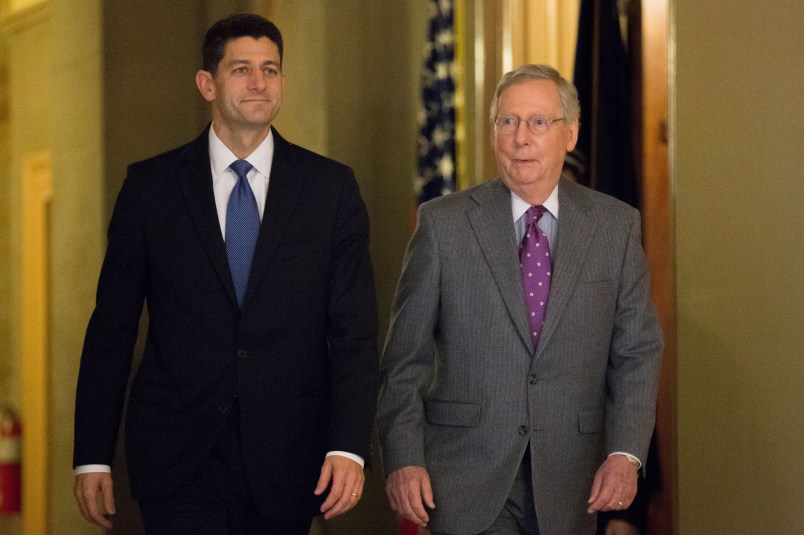Republicans in Congress kicked off their new session by taking the first steps toward repealing Obamacare.
The moves were mostly procedural and more-or-less expected, but they nonetheless signaled that GOP lawmakers intended to follow through on their promises last year to make dismantling the Affordable Care Act priority No. 1.
The first move, in the House, was the introduction of new chamber rules before Christmas and approved by the full body Tuesday, that included a special glide path for their Obamacare efforts. The second was a budget resolution introduced by Senate Budget Committee Chairman Mike Enzi (R-WY) Tuesday to jump-start the budgetary maneuver known as reconciliation, by which Republicans will be able to avoid a Democratic filibuster in the upper chamber.
Together the two moves reflect the complicated procedural path Republicans will have to navigate to get a repeal bill to the White House
“There are various points of order that could come up in this process,” David Reich, a former House appropriations staffer now at the Center on Budget and Policy Priorities, said, referring to the move lawmakers can use to claim that a piece of legislation is in violation of parliamentary rules.
“They seem to be getting their ducks in a row to maneuver around the points of order,” Reich said.
Not long after Donald Trump was elected president, GOP lawmakers made clear their intent to use reconciliation to repeal Obamacare, following the model of 2015 legislation that was vetoed by President Obama last year. Though some Republicans have expressed reservations about going forward with repeal without a replacement plan ready, Tuesday’s introduction of the budget resolution suggests lawmakers are willing to charge forward nonetheless. The resolution is not meant to become law, and thus won’t need a president’s signature. In this case it merely exists as a vehicle directing the committees relevant to an ACA repeal to begin working on the reconciliation bill.
“All this does is it triggers the start of a process where Congress would have agreed to a reconciliation directive,” said Richard Kogan, a former senior adviser at the Office of Management and Budget before joining the Center on Budget and Policy Priorities.
Once the resolution is approved by a majority vote in both chambers, committees in the House (Energy and Commerce; and Ways and Means) and in the Senate (Finance; and Health, Education, Labor, and Pensions) will start working on the actual repeal legislation which will spell out just what parts of Obamacare Republicans will dismantle. The resolution gives the committees until Jan. 27 to submit their proposals, but that deadline is somewhat arbitrary.
“That’s a goal that they set for themselves, but that’s not totally binding,” said G. William Hoagland, senior vice president at the Bipartisan Policy Center who worked 25 years on the Senate staff, including on the Senate Budget Committee.
After the various committees approve their respective bills, they’re sent to the respective budget committees in the House and Senate, which will cobble together the bills into a single piece of legislation. That legislation will then go for a floor vote in both chambers, and possibly will need to be conferenced between the House and Senate versions. Then the legislation would head to President Trump for his signature.
The resolution introduced Tuesday is written in a way to anticipate potential run-ins with budget rules that could stand in the way of the repeal effort, as well as possible partial replacements Republicans might offer. One section gives the chairs of the House and Senate budget committees the ability to adjust the numbers in the budget resolution as they pertain to health care related legislation, as long as the legislation doesn’t cumulatively increase the deficit over next 10 years.
Such an exemption would cover a plan that — as the 2015 legislation did — repealed Obamacare tax credits right away while delaying repeal of its subsidies for a few more years as part of a transition period.
The next section, meanwhile, lays the groundwork for lawmakers to try to capture any savings from Obamacare repeal to put towards a replacement, an idea that’s been floated as sort of a “piggy bank” to get around the fact that Republicans are likely to abolish many of the taxes that funded Obamacare itself.
“That section says, ‘Okay, have you saved money in the first ACA repeal? Then you can spend some of it in your partial replacement bill,’” Reich said.
The House rules changes passed Tuesday were another piece of the puzzle complementing the Senate resolution to guide the repeal process away from congressional budgetary rules. The rules package renewed a previous rule limiting legislation that included an increase in direct spending by $5 billion. But the House added to the rules a provision that exempted legislation “repealing” or “reforming” the Affordable Care Act.
According to Hoagland, that language acts as “window dressing” that “allows for those people that are concerned what the replacement legislation is going to be, to be able to tell those people, ‘It’s possible that replacement legislation could increase spending.'”
“It’s so hard to do this reform without increase spending,” Hoagland said
In practicality, as the New York Times reported, it will prevent Democrats in the House from invoking a point of order as a way of gumming up the works. Minority Leader Nancy Pelosi (D-CA), nonetheless, mocked the language in a press call with reporters Monday.
“In that rule, they really admit that by repealing the Affordable Care Act, it will increase costs and that is why they have violated their own principle,” she said.











I’m bookmarking
For all the talk about how repeal doesn’t really work without replacement…here we are.
So in seventeen days…nah.
the American people should rise up
We are just measuring right now how stupid they are (“Americans voted for change!”) and I bet you they earn high high marks on that ignoble scale.
I would think that pure repeal would give grounds for lawsuits, as there are existing obligations.
I would seriously give good money for a documentary about some of the millions of people who will die because of the ACA repeal. I want congress to see these people’s faces as much as possible. Huge posters with the faces of the condemned outside congress. How do I help make that happen?
So they covered their asses with language permitting them to add to the deficit, which isn’t that a big time yuuuuuuuuuuuuuuuuuuuuuuuuuuuuuuuuuge no-no in Republican land? But hey people will lose their healthcare, people will die so there’s that yuuuuuuuuuuuuuuuuuuuuuuuuuuuuge bigly win for Republicans.
Oh did I forget I’m sure there will be some related job losses-so how you’re gonna tweet fix that Pres. Donnieboy?